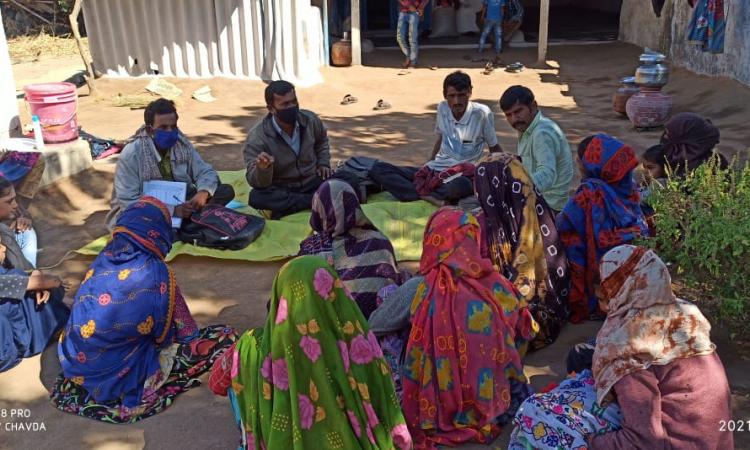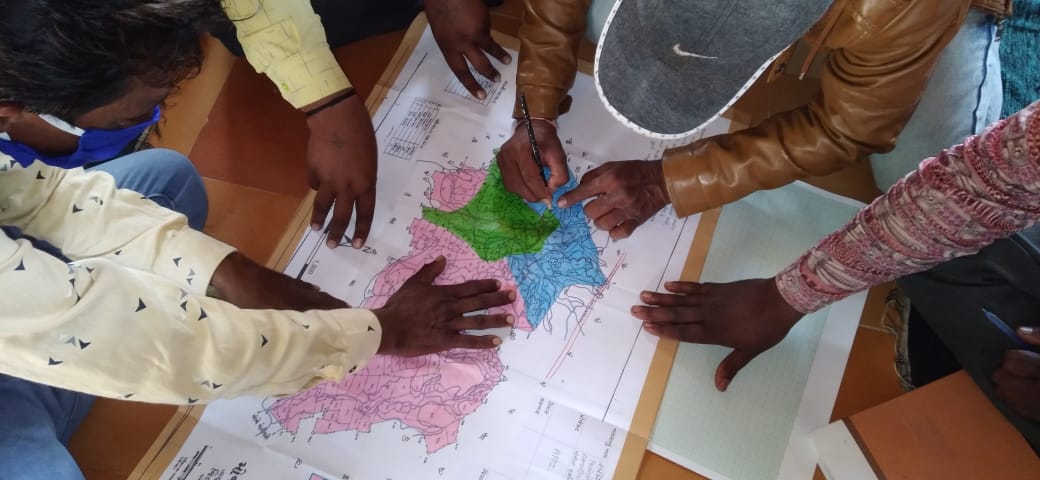
Samerth has been working since 2000 on providing safe water to the marginalised communities in the remote areas of Rapar and Bhachau blocks of Kutch district in Gujarat. This is a drought-prone area surrounded by big and small Rann (desert) with an unpredictable monsoon. Groundwater being scarce, there is a pronounced dependence on surface water.
When Samerth began working on water issues, it observed how a single poor monsoon would result in a mass exodus from the villages as there would be an immediate shortage of water for drinking, cattle, agriculture etc.
Samerth started working with local communities to build their capacities on basic geohydrology, incorporating traditional wisdom, preparation of a water budget and finally a water security plan (WSP) of the village. This plan would be authenticated in the gram sabha and a resolution to implement it through its finances passed by the panchayat.
This helped involve and in some instances activate panchayat bodies such as the Village Water and Sanitation Committee. Women were involved in the process of developing the water budget from a gender lens. The Talati (revenue officer), water board officials of the block, as well as the most marginalised people, were brought together for the planning.
A cadre of individuals from the community - Jaldoots in local parlance has been developed to achieve a better impact. Samerth has trained more than 40 men and women as Jaldoots who have made great inroads in the last 4 years. This meant equipping them with an understanding of modern technology and its uses, such as - global positioning systems (GPS), different Applications (Apps) and lastly online interactions, which became a norm during the pandemic.
Most Jaldoots had never used a smartphone and thus the training began from basic technology and then moved on to higher skills and knowledge. Now the group of Jaldoots are also into making films and short videos.
Initiatives by the government
The Atal Bhujal Yojana (ABhY) and Jal Jeevan Mission (JJM) are a step in the right direction with community participation as its core. The Applications developed by the government for data collection and collation make these a technically sound program. At the time of writing this article, we found gaps in training and understanding on the ground on the data (primary vs. secondary, verifiable sources etc).
The data collected through these Apps should be made accessible to all so that constant reinvention of the wheel can be avoided. Currently, data is collected by many sources but due to the lack of an authentic source, there is a wide discrepancy.
Self-sustainable model - a farfetched dream or reality in near future?
Expertise in water management is much needed in a region like Kutch where we are continuously facing water shortage. The poorest people who are heavily caught up in their struggle for survival invariably face a shortage. Planning or visioning on anything – including water is not an immediate priority. It is here that civil society organisations can create an environment where such services become a priority.
Samerth envisions a water resource centre at cluster level across India providing demand-based services on water testing, soil testing, water budgeting, support and advice on optimum methods for water harvesting and other technical services for water conservation and governance.
Training has been provided to Talati of Rapar block of Kutch district on the preparation of Gram Panchayat Development Plan (GPDP) as per government norms. Ensuring community participation and active involvement in developing GPDP and perspective plans has been a priority.
The entire bottom-up approach of developing GPDPs in panchayats with the community’s active participation has enabled the members of marginalised groups to voice their needs. Community provided inputs during the preparation of the WSPs and GPDPs of 97 villages of Rapar block facilitated by Samerth.

Role of local institutions in water management
Kutch is a semi-arid region surrounded by the Greater Rann of Kutch and the Arabian sea. Rapar block where Samerth has been working for 20 years faces challenges in water management. It lies near the small and Greater Rann of Kutch and its groundwater is saline. For its drinking and irrigation purposes, the community mostly depends upon the surface water sources such as ponds.
Management of these surface water bodies through the local institutions, which can govern the distribution of water becomes very crucial. These institutions also frame the rules for the sustainable, equitous and judicious use of water by the community. In absence of the local institutions, these water bodies were being over-exploited by the dominant sections (castes) of the community.
The existing layout of the villages, with their segregated arrangement, often leaves the vulnerable households behind. In Rapar and Bhachau blocks, the gram panchayats have many hamlets that are far away from the main village (8 to 10 km without proper roads). It becomes all the more difficult to get the families from these areas on board to access their basic entitlements.
The role of local institutions and Panchayats become very crucial for water management considering the caste, class, and gender dynamics. For Samerth, getting women to work as ‘Jaldoots’ was very challenging. The work was considered as men’s domain and the villagers were unwilling to accept women in this role. To begin with, Samerth was able to get 7 women in a group of 40 Jaldoots. Most of them were from the Other Backward Community.
The work was very empowering for these women. Two of the young women found this work so satisfying that they convinced their family to sell one of the several buffaloes they own to purchase a two-wheeler to commute to villages. Similarly, another Jaldoot decided to complete her higher secondary education. So, most of the community persons not only improved their competencies to work in the water sector, but gained an understanding of governance and social dynamics. They also focused on their self-development.
Skills required for VWSC/GP to ensure long-term village water security
To manage water sustainably, GPs should have skills in assessing water demand and supply in the village. They also need to assess the distribution of water in the village across sectors - agriculture, domestic, cattle consumption and industrial purpose.
Based on this data, watershed planning can be initiated in the villages. Watershed planning is usually based on seven different themes (base map, land use map, geomorphology map, surface geology map, surface morphology map, water resource map and watershed planning map). Samerth has helped develop these plans in 25 GPs. Based on these maps, detailed water management planning is being done in the villages. Also, the 97 WSPs facilitated by Samerth has estimated the overall needs of the villages and hamlets and devised a long-term plan for the region.
Disaggregated data is crucial for appropriate planning. To ensure that the less vocal is heard, the representation in the VWSC needs to be more diverse. The people involved in the process need to have a basic knowledge of the requirements and should be able to read the basic data that is available in the WSPs and various maps.
Demand for Jaldoots in water-stressed regions
Jaldoots can help the local communities in water resources planning for the region/hamlets/villages. These persons have been skilled with the support from NGOs such as Samerth in various aspects such as watershed planning, water quality assessment and management, soil quality assessment and community mobilisation. Many of them have emerged as water experts.
There is demand from community members for support from the Jaldoots in selecting sites for water conservation structures. The Jaldoots can earn by providing their services. Also, they can be supported through the panchayats.
Many farmers and community members need technical information before developing any water structures for conserving rainwater at the community and individual level. If they realise that such structures have to be properly designed, they will value the services provided by Jaldoots. The communities are now seeking this support from Jaldoots. If the Jaldoots become part of the government system or are certified by the government agencies, their legitimacy and authenticity will increase considerably.
The Jaldoots can also double up as MGNREGA mates or Banking Correspondents to become self-sustainable. In Samerth’s project area, Jaldoots have acquired other skills such as soil testing and water quality testing. The farmers and community are willing to pay for these services. Jaldoots are called upon by the departments working on watershed and sarpanches to support them in preparing yearly budgets and plans in their respective panchayats.
The recognition of skills at the GP level can go a long way. The persons who acquired these skills can be validated as Jaldoots or Bhujal Jankars under the government programme (JJM, ABhY) in the village. The Panchayat and VSWCs can use these skills for creating demand for the implementation of various programmes under MGNREGA, participatory groundwater management (PGWM), drought-proofing work, use of the wasteland for fodder development, setting up of seed and fodder bank, collective purchase of seeds and selling of crop produce.